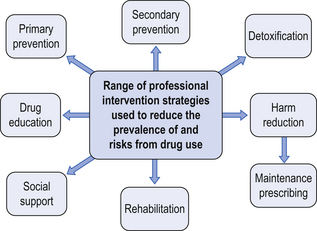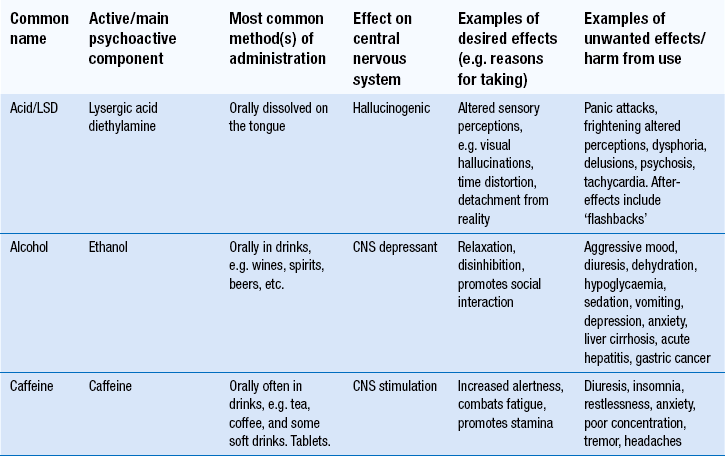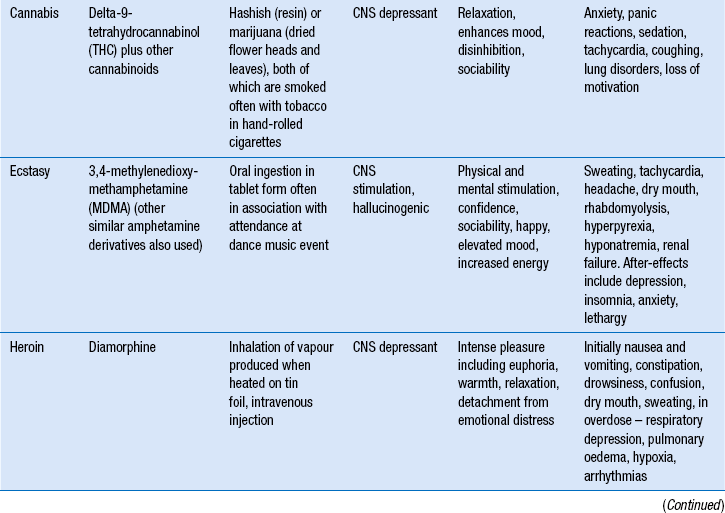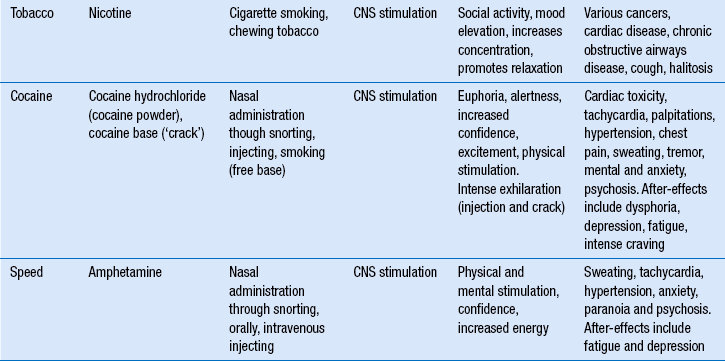50 This chapter begins with some background information before it summarizes current thinking on drug misuse and drug dependence. It then looks at treatment provision in the UK and the range of interventions used, focussing on the practical provision of the two main pharmaceutical interventions: needle exchange and substitute pharmacotherapy provision. Dependence can be classified in more detail, as found in the Shorter Oxford Textbook of Psychiatry. ‘Drug user’ is commonly used to refer to someone who participates in drug/substance use. The term ‘drug misuser’ refers to someone undertaking drug use in such a way that it is problematical and presents significant risk of harm. The two terms tend to be used interchangeably. Terms such as ‘drug addict’ and ‘drug abuser’ are less used in recent literature. Table 50.1 lists some commonly used psychoactive substances in western societies and summarizes their effects. (Nicotine is included for completeness: the role of the pharmacist in smoking cessation is covered in Ch. 48). The unwanted and harmful effects of some drugs relate to prolonged and excessive use, whereas others occur with single doses of smaller amounts. The method of administration also influences the extent of the risks, e.g. injecting opiates presents greater health risks than taking them by vaporization (‘chasing the dragon’). Table 50.1 is presented as a guide, but it is not comprehensive. The decision to use a drug may be influenced by many things, including: A lack of specific types of neurological control is sometimes given as the reason why some people develop addictions to specific psychoactive drug(s) whereas others do not. Published studies can be criticized as the models of behaviour are largely shown in animals not humans. Nevertheless, neurological processes manifest positive and negative reinforcement of drug seeking and taking behaviours, with genetic variations influencing these. These are psychological disturbances experienced when a drug is removed. These cannot be so easily observed or measured in the way that many physical withdrawal effects can, but they must not be underestimated. Psychological withdrawal includes intense craving, intense emotional experiences such as unmasking of grief, inability to cope, altered mood and depression, which may be prolonged and severe. It tends to be of long duration and contributes markedly to relapse back to drug use. Drug-related crime includes not only the criminal activities committed against the Misuse of Drugs Act (see below) for which the individual is punished, but also crime that impacts on communities and society at large. The latter may relate to the acquisition of drugs or the effects of drugs, e.g. burglary to obtain money to buy drugs, robbery, violence associated with drunkenness, drunk/drug driving. Drug-related crime is of concern to society and is one of the reasons why treatment of drug problems and drug dependence is a key public health issue (see Ch. 13). Additionally, there is evidence that treatment of drug dependence contributes towards a very marked reduction in drug-related crime. Hence, treatment benefits not only the individual in terms of improved health but also society by making communities safer. The Misuse of Drugs Act 1971 classifies drugs into Class A, Class B and Class C. The purpose of this legislation is to define the penalties imposed for the illegal undertaking of various activities, e.g. possession, supply, import, and export. These are summarized in Table 50.2. This classification system is different from the Misuse of Drugs Regulations that largely govern dispensing and other activities of the pharmacist. Table 50.2 Classification of some commonly misused substances according to the Misuse of Drugs Act 1971 aThe term ‘supply’ includes drug trafficking and unauthorized production. bIf Class B drugs are prepared for injection they become Class A. cUnless prepared for injection when amphetamines become Class A. Pharmacists are primarily involved with the treatment of dependence rather than interventions aimed at recreational and non-problematic drug use. The prevalence of drug dependence on a population basis is relatively small compared with national statistics that estimate numbers of people who have ever tried drugs. However, the extent of harm from drug dependence can be large; hence the need for effective strategies to support people in changing their drug use. Since the 1990s, treatment, criminal justice and prevention initiatives in the UK have been guided by government drugs strategies. Figure 50.1 illustrates the range of methods used in preventing, reducing and controlling drug use and dependence and managing the adverse consequences. Figure 50.1 The range of professional intervention strategies used to reduce or manage drug use and dependence.
Substance use and misuse
 The main psychoactive substances taken for non-medicinal purposes
The main psychoactive substances taken for non-medicinal purposes
 The range of professional interventions used in the field of substance misuse
The range of professional interventions used in the field of substance misuse
 The aim of pharmaceutical interventions and their operation
The aim of pharmaceutical interventions and their operation
 Key factors to consider when providing pharmaceutical care to people with drug misuse problems
Key factors to consider when providing pharmaceutical care to people with drug misuse problems
Introduction
Terminology
Substances that are used and their effects
Why do people use psychoactive drugs?
Choice of drug used
Control and dependence
Withdrawal
Psychological withdrawal effects
The harms relating to psychoactive drug use and dependence
Drug-related crime
Legislation
Misuse of Drugs Act
Class
Drugs
Maximum penalties
A
Cocaine including crack cocaine, diamorphine (heroin), dipipanone, ecstasy, LSD, methadone, morphine, opium, pethidine
7 years imprisonment and/or unlimited fine for possession.
Life imprisonment and/or fine for supplya
Bb
Most amphetaminesc, cannabisd, codeine, dihydrocodeine, methylphenidate
5 years imprisonment and/or fine for possession.
14 years imprisonment and a fine for supply
C
Benzodiazepines, anabolic steroids and growth hormones
2 years imprisonment and/or fine for possession.
14 years imprisonment and/or fine for supply
The management of drug use and dependence

![]()
Stay updated, free articles. Join our Telegram channel

Full access? Get Clinical Tree












